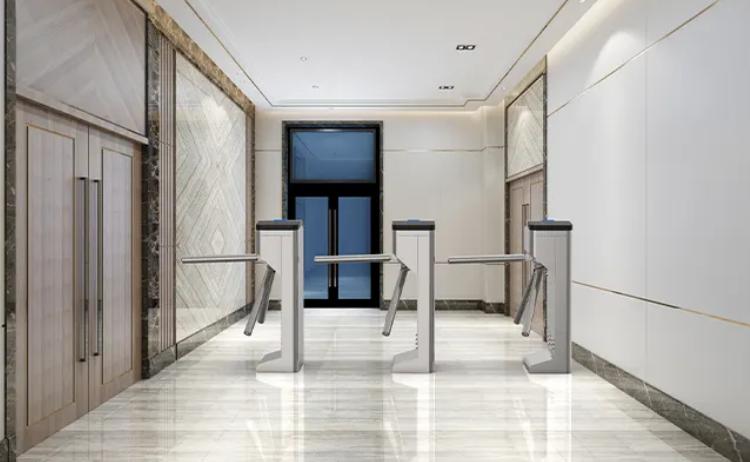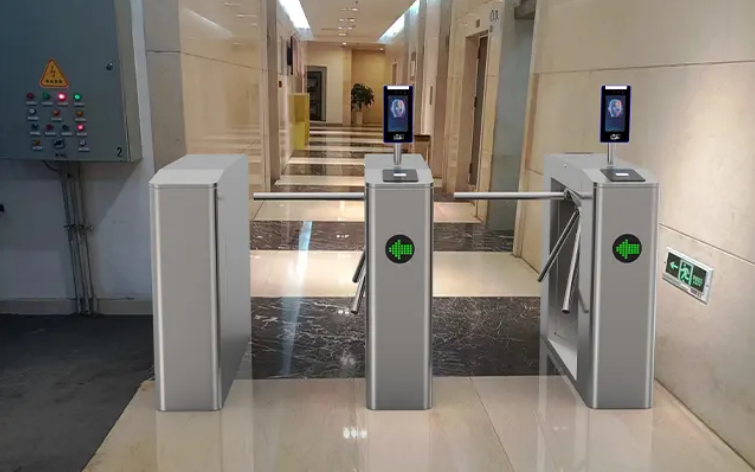Future-Proofing: What’s Ahead for Flap Barrier Technology


Flap barrier technology is a widely used access control solution seen in airports, office buildings, metro stations, and other high-traffic areas. It uses motorized flaps that retract or extend to control entry or exit based on user credentials like keycards, biometric data, or QR codes. Designed to provide fast and secure passage, these systems balance safety, speed, and convenience.
But flap barriers aren’t standing still. As industries move toward smarter, more interconnected systems, the humble flap barrier is transforming. Think of it as moving from a flip phone to a smartphone—the barrier of the future won’t just open or close; it will think, learn, adapt, and even communicate with other systems in your building.
This evolution is being driven by the need for increased security, efficiency, and hygiene. Facility managers are now seeking not just any barrier but one that can anticipate future needs and integrate into broader smart security infrastructures. That’s where the concept of future flap barrier tech steps in—offering solutions that evolve with changing demands.
Why Future-Proofing Matters
Imagine spending thousands on access control today only to find your system outdated in two years. That’s the risk of not future-proofing. As AI, biometrics, mobile credentials, and sustainability become standard, today’s static systems might fall short tomorrow.
Future-proofing means choosing technology that doesn’t just meet today’s needs but is flexible enough to scale and integrate with tomorrow’s innovations. It’s about keeping your facility ready for new security threats, regulatory requirements, and user expectations.
For decision-makers like facility managers and procurement teams, future-proofing offers long-term value. It minimizes costly overhauls, ensures regulatory compliance, and enhances user experience—all while keeping up with smart security trends. It’s not just a buzzword; it’s a survival strategy in a rapidly changing tech landscape.
AI and Machine Learning in Flap Barriers
Smarter Threat Detection
The future of flap barriers lies in their brains—not just their barriers. Artificial intelligence (AI) is turning traditional systems into intelligent gatekeepers. By learning from behavior patterns and user data, AI-powered barriers can detect anomalies like tailgating, piggybacking, or unauthorized entries with higher precision.
Imagine a barrier that doesn’t just open based on a card swipe but evaluates user behavior. Did the person hesitate unusually? Was there an attempt to follow another user too closely? AI can detect such patterns and trigger alerts, improving threat response time.
Machine learning algorithms are also reducing false positives. They learn over time what constitutes “normal” versus “suspicious” behavior, making your security system smarter and more reliable.
Facilities handling sensitive data or hosting critical infrastructure can greatly benefit. From corporate headquarters to research labs, this tech ensures that only the right people get through—every time.
Adaptive Access Control in Real-Time
AI doesn’t just react—it adapts. In the future, expect flap barriers to change access permissions in real-time based on evolving situations. Let’s say there’s an emergency—AI can lock down specific areas while rerouting people to safer exits. Or, during a high-security event, it can temporarily upgrade access rules.
This adaptive access control makes facilities more resilient. It enables security protocols to shift dynamically rather than relying on static rules that may be obsolete in changing contexts.
Moreover, integrating AI helps with queue management. The system can detect crowd buildup and adjust flap speeds or open additional gates to maintain flow. It’s this level of intelligent flexibility that defines innovation in flap barriers.
Biometric Security Innovation
Rise of Multi-Modal Authentication
Gone are the days when a single fingerprint or card swipe was enough. The future demands multi-modal authentication—where users must verify identity using two or more biometrics, such as face and fingerprint or iris and voice.
Why? Because no single biometric is foolproof. Fingerprints can wear out or be spoofed. Faces can be obstructed. Combining multiple identifiers drastically increases security while reducing errors.
This multi-layered approach is becoming the new gold standard in smart security. Facilities that require a high degree of assurance—like financial institutions, data centers, and government offices—are moving in this direction fast.
Benefits of Face + Fingerprint Systems
Pairing facial recognition with fingerprint scanning has several advantages. First, it minimizes identity fraud. Even if one metric is compromised, the second provides a backup check. Second, it speeds up the process. With facial recognition happening passively (as users approach), and fingerprints confirming intent, the user flows smoothly without delays.
Another big benefit? Hygiene. Facial scans reduce the need for touch, making systems more sanitary—something crucial in post-pandemic facility management.
Systems using face + fingerprint also adapt well to different environments. In dusty, outdoor, or noisy locations where one biometric might fail, the other ensures continuity.
Modern barriers can now integrate both sensors into the gate interface, creating a seamless, contactless, and secure user journey—exactly what the market demands in trends 2025.
Embracing Contactless and Mobile Credentials
Reducing Physical Touchpoints
One of the clearest outcomes of recent global health concerns is the need for touchless access control. Touching shared surfaces like keypads or fingerprint scanners became a hygiene risk overnight. In response, future flap barrier tech is going contactless—and it’s not just a trend, it’s a requirement.
Technologies such as RFID, NFC, Bluetooth Low Energy (BLE), and even facial recognition are replacing physical contact methods. Users can now wave a mobile phone, swipe a contactless badge, or simply approach the barrier to gain access. These methods not only enhance safety but speed up entry, especially during rush hours in places like subways or corporate lobbies.
These advancements also eliminate issues like worn-out cards or forgotten access codes. In essence, it’s about creating a faster, safer, and more seamless flow, which aligns perfectly with the expectations of modern building occupants.
Improving User Experience and Traffic Flow
Contactless access isn’t just about safety—it’s a major boost for convenience and efficiency. Think about high-traffic venues like stadiums, airports, or convention centers. Reducing the time per entry by just a few seconds can prevent backups and long queues.
Mobile credentials are especially promising. Users no longer need to carry a separate badge—they can just use an app on their smartphone. Integration with mobile wallets also opens doors for dynamic access management, such as time-based credentials or single-use event passes.
For facilities managers, mobile credentials are easier to distribute and revoke. Lost phones are easier to deactivate remotely than physical cards. And because smartphones can carry multiple credentials, one app can offer access to parking, elevators, and restricted rooms—all through one device.
It’s no wonder this shift is central to trends 2025 in the access control industry.
IoT-Connected Barriers
Predictive Maintenance Features
The Internet of Things (IoT) is bringing predictive intelligence to flap barrier maintenance. Instead of waiting for a mechanical issue to cause a breakdown, IoT sensors can now detect wear and tear, motor strain, or unusual usage patterns—triggering alerts before a failure happens.
That means fewer downtimes, lower repair costs, and a more reliable access control environment. Predictive maintenance also extends the life of the barrier system by encouraging timely service based on real data rather than guesswork.
For building operators, this tech adds transparency. Dashboards can show real-time status of each barrier, including usage counts, health metrics, and upcoming maintenance needs.
Data Analysis and Remote Monitoring Capabilities
With IoT-enabled systems, flap barriers are no longer isolated units. They’re part of a connected infrastructure that gathers and analyzes data continuously. From monitoring usage trends to identifying peak traffic hours, this data empowers better operational decisions.
Facilities can optimize staffing based on traffic patterns or adjust access privileges based on behavior analytics. Integration with surveillance systems and alarms allows for rapid response to unauthorized entries.
Remote control is another game-changer. Security teams can manage multiple entrances across different buildings from a central control room—or even via mobile app. This is especially critical for large campuses or multi-site operations.
IoT turns flap barriers from passive gates into intelligent, networked security nodes—a major leap in smart security evolution.
Focus on Sustainability
Low-Energy Motors and Eco-Friendly Materials
Sustainability is no longer optional—it’s expected. Building codes, corporate ESG goals, and customer demand are pushing manufacturers to design greener products. Future flap barrier systems are answering the call with low-energy motors that reduce power consumption without sacrificing performance.
Some motors even feature regenerative braking systems, converting motion into usable power. Combined with efficient standby modes and sensors that only activate components when needed, these upgrades reduce a building’s overall energy footprint.
Materials are getting a makeover too. Instead of traditional plastics or metal alloys, manufacturers are exploring recycled aluminum, sustainable composites, and biodegradable casing materials. Every part—from the motor casing to the access panel—is being rethought for a lower environmental impact.
This shift is not just about feeling good—it can directly reduce operating costs, appeal to green-certified buildings, and improve public perception.
Lifecycle and Recyclability of Components
Beyond daily energy use, future-proofing involves thinking long-term. What happens when your flap barrier reaches end-of-life? Newer designs emphasize recyclability—using modular components that can be disassembled and repurposed instead of dumped into landfills.
The goal is to create a circular lifecycle, where outdated parts can be recycled or upgraded, extending the lifespan of the entire system. Manufacturers offering take-back programs or parts replacement services will gain competitive edges.
Sustainability is becoming a key differentiator in procurement decisions. As building certifications like LEED or WELL require greener systems, flap barriers need to comply to remain viable choices for forward-thinking buyers.
Integration with Building Management Systems
Centralized Security and Operational Control
Flap barriers are no longer stand-alone devices—they’re integral to a building’s digital nervous system. The future lies in seamless integration with Building Management Systems (BMS), enabling centralized control of lighting, HVAC, surveillance, and access from a single dashboard.
Why is this so critical? Imagine a fire alarm goes off. A centralized BMS-integrated flap barrier system can immediately open all barriers to facilitate evacuation or lock down specific zones for containment. It’s a level of synchronized automation that standalone systems simply can’t offer.
From a daily operations perspective, this integration streamlines security protocols. Security teams can manage user access, monitor system health, and even trigger alerts from the same platform used to control elevators or lighting. This unified approach reduces human error and boosts operational efficiency.
The ability to aggregate data from flap barriers and other systems enables smarter decision-making. Whether it’s understanding traffic flow or correlating access events with security footage, this synergy results in truly smart security.
Smart Analytics for Building Intelligence
Modern buildings thrive on data. With integrated flap barriers, building operators gain access to high-resolution analytics that track user movement, identify peak usage periods, and even spot behavioral trends over time.
This level of building intelligence helps with staffing, maintenance scheduling, and energy management. For instance, if flap barrier data shows reduced weekend traffic, HVAC and lighting can be automatically adjusted for savings.
Even safety protocols benefit. Analyzing access patterns may highlight security blind spots or unauthorized access attempts, allowing for proactive adjustments in real-time.
Analytics can also fuel predictive modeling. Facility managers can simulate “what-if” scenarios—like how a conference or event would impact access points—leading to more informed planning and better guest experiences.
Cloud-Based Access Control Solutions
Real-Time Updates and Configuration
Cloud-based access control is reshaping how facilities manage flap barriers. Unlike traditional on-premises systems that require manual updates and on-site access, cloud platforms allow for remote configuration, user management, and software updates.
This is especially useful for businesses with multiple locations. An admin sitting in New York can update access permissions for a London office instantly. Cloud systems offer dynamic credentialing, meaning access rights can be granted, modified, or revoked in real-time.
Flap barriers integrated with cloud solutions are also inherently more secure. Software patches for vulnerabilities can be pushed instantly, reducing exposure to cyber threats.
This capability ensures that access control systems remain up-to-date with the latest features and compliance standards—key components of any future-proof strategy.
Scalability and Remote Access Advantages
Scalability is one of the strongest benefits of cloud-connected flap barriers. Whether managing 10 users or 10,000, cloud platforms can scale instantly without the need for expensive hardware upgrades.
As a business grows, new locations or access points can be integrated into the existing system without starting from scratch. This flexibility makes cloud-based solutions cost-effective and future-ready.
Remote access is another win. Security staff can view logs, grant temporary access, or lock/unlock barriers from any device, anywhere. This 24/7 control enhances responsiveness, particularly during emergencies or after-hours situations.
Cloud solutions also facilitate better data retention and reporting. Monthly usage summaries, audit logs, and anomaly alerts are easy to generate and share—essential for compliance and internal reviews.
Compliance and Regulatory Trends
Global Safety Standards
As flap barrier technology evolves, so too does the regulatory landscape. Governments and industry bodies are introducing stricter guidelines for physical security, data privacy, and accessibility. Future barriers will need to meet global safety standards that ensure not only secure access but also user safety during operation.
New regulations emphasize anti-trap features, emergency override capabilities, and intuitive interfaces for disabled users. These requirements push manufacturers to innovate safer, more inclusive designs.
Security certifications like UL294 or EN 16005 are becoming benchmarks, and failing to comply may disqualify a product from certain markets. Buyers need to ensure that any flap barrier system they invest in can meet—or exceed—these evolving benchmarks.
Keeping up with regulatory changes isn’t optional—it’s essential to remain compliant, avoid penalties, and uphold a reputation of trustworthiness in secure facility operations.
Smarter Design Guidelines for 2025 and Beyond
Design is no longer just about aesthetics; it’s about usability, safety, and future-readiness. Guidelines for 2025 and beyond are shaping the way barriers are built—from ergonomic height and placement to AI-integrated panels and energy-efficient operation.
Smart design now includes features like adaptive LED displays for status notifications, voice prompts for navigation, and biometric-friendly interfaces. Materials must be durable yet recyclable, sleek yet safe.
Universal accessibility is becoming standard. Expect to see features like wider lanes for wheelchairs, intuitive touchless controls, and better integration with auditory and visual aid systems.
This evolution in design reflects a shift from reactive to proactive thinking—anticipating user needs before they become compliance issues. Future-ready buyers should demand products that align with these innovation trends to avoid premature obsolescence.
Buyer’s Guide to Future-Proofing
Practical Strategies for Upgrading Existing Systems
Future-proofing doesn’t always mean starting from scratch. For many facility managers, upgrading existing flap barrier systems is a more realistic—and budget-friendly—approach. The trick is knowing which components to prioritize.
First, assess compatibility. Can your current system integrate with cloud access control, IoT sensors, or biometric modules? If yes, retrofitting may be a viable path. Look for modular systems that allow easy component swapping, such as adding mobile credential readers or upgrading control boards to handle AI logic.
Second, consider software. Many outdated systems can be refreshed with new firmware or cloud platforms that dramatically increase functionality. These updates often enable remote monitoring, better analytics, and tighter integration with smart security systems.
Third, work with future-focused vendors. Choose manufacturers who offer forward compatibility—systems designed with expansion and integration in mind. Opt for suppliers who actively innovate and support their products for the long haul.
Upgrades can also include peripheral systems. Enhancing surveillance around your barriers, deploying occupancy sensors, or adding signage can all elevate the user experience and safety without overhauling the core hardware.
How to Choose Forward-Compatible Barriers
Buying a new flap barrier today? You need to ensure it won’t become obsolete tomorrow. Look for features that suggest the system is designed with the future in mind:
- Modular architecture – allows parts to be replaced or upgraded individually.
- Open APIs – enables integration with existing and future building systems.
- Cloud-readiness – ensures real-time updates and off-site control.
- AI and biometric support – ensures better security and personalization.
- Compliance certifications – confirms it meets the latest safety standards.
Also, review the vendor’s roadmap. Are they investing in innovation? Do they release regular updates or have a track record of staying ahead of the curve?
Future-compatible systems reduce the total cost of ownership. They extend lifecycle, reduce downtime, and scale with your organization. In short, they’re an investment in stability and growth.
Innovation in Flap Barriers
Key Takeaways from Industry Leaders
The companies at the forefront of flap barrier innovation share some key philosophies: adaptability, intelligence, and user-centric design. Industry leaders are rapidly evolving beyond simple physical gates into fully integrated, responsive systems that play a critical role in a facility’s ecosystem.
Brands leading in future flap barrier tech are embracing facial authentication, dynamic QR code scanning, and frictionless mobile access. They’re embedding sensors to monitor performance, integrating machine learning for predictive capabilities, and building modular frames that adapt to various use cases.
One standout trend? Integration with facial recognition AI that adapts based on user behavior and environmental context—adjusting recognition algorithms in bright light, shadows, or even if a user wears a mask.
Another breakthrough is hybrid turnstile-barrier combos, which combine the speed of swing barriers with the tight security of flaps, offering flexibility for varying access levels in a single lane.
Upcoming Features and Prototypes to Watch
If you’re planning your next investment, here are the upcoming features that could redefine flap barriers in 2025 and beyond:
- Self-healing systems: Barriers that detect internal malfunctions and correct them automatically.
- Dynamic risk scoring: AI assigns threat levels to users based on behavior history.
- Real-time video recognition: Integrates surveillance feeds with access logs to identify threats.
- Edge computing: Allows AI decisions to be made on-device without cloud delay.
- Gesture-based entry: Users wave or nod instead of touching or presenting credentials.
These prototypes suggest a future where flap barriers are not just smarter, but truly intelligent—capable of adapting, learning, and supporting a broader smart security infrastructure.
Exploring Trends 2025
Market Shifts and Buyer Expectations
The flap barrier market is undergoing a radical transformation. Buyers aren’t just looking for hardware—they want smart, integrated ecosystems. This shift is fueled by growing expectations around safety, speed, hygiene, and data.
Sectors like healthcare, education, and transportation are driving demand for mobile-first, biometric-enabled systems. Meanwhile, corporate buyers expect full integration with enterprise software and compliance systems.
Another trend: subscription-based models. Instead of buying the system outright, some companies are offering access-as-a-service, where you pay monthly for usage, maintenance, and updates. This appeals to organizations seeking flexibility and minimal upfront costs.
Global events like pandemics, cyber-attacks, and climate change are also shaping design priorities. Barriers must now account for hygiene, cybersecurity, and energy efficiency in equal measure.
To stay competitive, vendors are rapidly innovating. The trends for 2025 are clear—modular, contactless, intelligent systems will dominate.
Technology That Will Dominate the Coming Years
The tech stack defining the next wave of flap barriers includes:
- AI: powering facial recognition, behavioral analytics, and predictive alerts.
- IoT: enabling sensor-rich barriers that talk to other systems.
- 5G: improving data transmission for real-time remote control.
- Cloud: allowing scalable, always-on access management.
- Sustainable design: emphasizing efficiency and eco-conscious materials.
As more cities and companies adopt smart infrastructure, these technologies will become standard—not optional. Buyers must plan accordingly, or risk being left behind in an outdated security model.
Case Studies and Real-World Applications
Success Stories from Smart Facilities
Take, for example, a major European airport that upgraded its flap barrier system to include facial recognition and IoT sensors. The result? A 40% faster passenger throughput and a 60% drop in unauthorized access attempts.
Or a Fortune 500 headquarters in Asia that moved from card-based barriers to a cloud-based mobile system. They saw reduced admin workload, easier credential management, and tighter security controls—all while maintaining a sleek, touchless user experience.
University campuses, data centers, and government buildings are adopting similar strategies. The common thread? A shift from hardware-only thinking to holistic, integrated security ecosystems.
ROI from Investing in Future-Ready Solutions
It’s not just about convenience—it’s about returns. Facilities investing in future-proof flap barriers report:
- Lower maintenance costs from predictive diagnostics.
- Reduced labor costs via remote access control.
- Faster onboarding for new users via mobile apps.
- Improved compliance through audit-ready logging and tracking.
These savings often justify the upfront investment within 12–18 months, making the ROI both measurable and rapid.
Conclusion
Preparing for the Next Generation of Smart Security
Flap barrier technology is evolving fast. What was once a simple physical gate is now a smart, connected, intelligent system that serves as the frontline of modern access control. Future-proofing is no longer a luxury—it’s a necessity.
From AI and biometrics to cloud and IoT, the innovations shaping future flap barrier tech are all about enhancing user experience, boosting operational efficiency, and strengthening security.
Whether you’re upgrading existing barriers or investing in new infrastructure, the key is flexibility. Choose systems that grow with your needs, adapt to emerging trends, and align with evolving compliance standards.
FAQs
1. What is the best biometric option for flap barriers?
Multi-modal systems combining facial recognition and fingerprint scanning offer the best balance of accuracy, hygiene, and user convenience.
2. Can existing flap barriers be upgraded with new tech?
Yes, many systems are modular. You can retrofit biometric readers, update software, or add IoT connectivity without replacing the entire unit.
3. How do cloud-based systems improve security?
They enable real-time monitoring, instant updates, and centralized control—helping facilities respond quickly to threats or policy changes.
4. Are sustainable flap barriers more expensive?
Not necessarily. While initial costs may be slightly higher, energy savings and longer lifespans often reduce total cost of ownership.
5. How does AI enhance access control?
AI enables smarter threat detection, learns user behavior over time, and can adapt access policies in real-time based on contextual factors.












